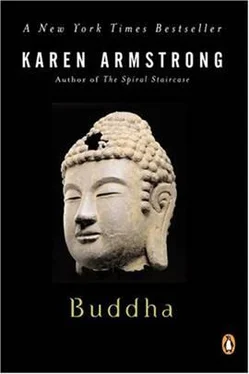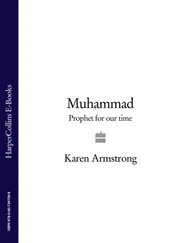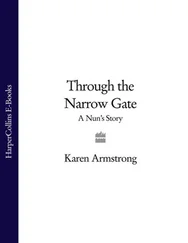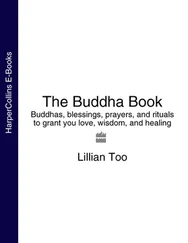Nibbana was not, therefore, a place like the Christian Heaven to which a believer would repair after death. Very few people in the ancient world at this point hoped for a blissful immortality. Indeed, by Gotama’s day, the people of India felt imprisoned eternally in their present painful mode of existence, as we can see from the doctrine of reincarnation, which had become widely accepted by the sixth century. It was thought that a man or a woman would be reborn after death into a new state that would be determined by the quality of their actions ( kamma ) in their present life. Bad kamma would mean that you would be reborn as a slave, an animal or a plant; good kamma would ensure a better existence next time: you could be reborn as a king or even as a god. But rebirth in one of the heavens was not a happy ending, because divinity was no more permanent than any other state. Eventually, even a god would exhaust the good kamma which had divinized him; he would then die and be reborn in a less advantageous position on earth. All beings were, therefore, caught up in an endless cycle of samsara (“keeping going”), which propelled them from one life to another. It sounds like a bizarre theory to an outsider, but it was a serious attempt to address the problem of suffering, and can be seen as inherently more satisfactory than attributing human fate to the frequently erratic decisions of a personalized god, who often seems to ensure that the wicked prosper. The law of kamma was a wholly impersonal mechanism that applied fairly and without discrimination to everybody. But the prospect of living one life after another filled Gotama, like most other people in northern India, with horror.
This is perhaps difficult to understand. Today many of us feel that our lives are too short and would love the chance to do it all again. But what preoccupied Gotama and his contemporaries was not so much the possibility of rebirth as the horror of redeath. It was bad enough to have to endure the process of becoming senile or chronically sick and undergoing a frightening, painful death once, but to be forced to go through all this again and again seemed intolerable and utterly pointless. Most of the religious solutions of the day were designed to help people extricate themselves from samsara and achieve a final release. The freedom of Nibbana was inconceivable because it was so far removed from our everyday experience. We have no terms to describe or even to envisage a mode of life in which there is no frustration, sorrow or pain, and which is not conditioned by factors beyond our control. But Indian sages of Gotama’s day were convinced that this liberation was a genuine possibility. Western people often describe Indian thought as negative and nihilistic. Not so. It was breathtakingly optimistic and Gotama shared this hope to the full.
When he left his father’s house clad in the yellow robes of a mendicant monk who begged for his food, Gotama believed that he was setting out on an exciting adventure. He felt the lure of the “wide open” road, and the shining, perfect state of “homelessness.” Everybody spoke of the “holy life” at this time as a noble quest. Kings, merchants and wealthy householders alike honored these bhikkhus (“almsmen”) and vied with one another for the privilege of feeding them. Some became their regular patrons and disciples. This was no passing craze. The people of India can be as materialistic as anybody else, but they have a long tradition of venerating those who seek the spiritual, and they continue to support them. Still, there was a special urgency in the Ganges region in the late sixth century b.c.e. People did not regard the renunciants as feeble drop-outs. There was a spiritual crisis in the region. The sort of disillusion and anomie that Gotama had experienced was widespread, and people were desperately aware that they needed a new religious solution. The monk was thus engaged in a quest that would benefit his fellows, often at huge cost to himself. Gotama was often described in heroic imagery, suggesting strength, energy and mastery. He was compared to a lion, a tiger and a fierce elephant. As a young man, he was seen as a “handsome nobleman, capable of leading a crack army or a troop of elephants.” People regarded the ascetics as pioneers: they were exploring the realms of the spirit to bring succor to suffering men and women. As a result of the prevailing unrest, many yearned for a Buddha, a man who was “enlightened,” who had “woken up” to the full potential of humanity and would help others to find peace in a world that had suddenly become alien and desolate.
Why did the people of India feel this dis-ease with life? This malaise was not confined to the subcontinent, but afflicted people in several far-flung regions of the civilized world. An increasing number had come to feel that the spiritual practices of their ancestors no longer worked for them, and an impressive array of prophetic and philosophical geniuses made supreme efforts to find a solution. Some historians call this period (which extended from about 800 to 200 b.c.e.) the ‘Axial Age” because it proved pivotal to humanity. The ethos forged during this era has continued to nourish men and women to the present day. Gotama would become one of the most important and most typical of the luminaries of the Axial Age, alongside the great Hebrew prophets of the eighth, seventh and sixth centuries; Confucius and Lao Tzu, who reformed the religious traditions of China in the sixth and fifth centuries; the sixth-century Iranian sage Zoroaster; and Socrates and Plato (c. 427-327), who urged the Greeks to question even those truths which appeared to be self-evident. People who participated in this great transformation were convinced that they were on the brink of a new era and that nothing would ever be the same again.
The Axial Age marks the beginning of humanity as we now know it. During this period, men and women became conscious of their existence, their own nature and their limitations in an unprecedented way. Their experience of utter impotence in a cruel world impelled them to seek the highest goals and an absolute reality in the depths of their being. The great sages of the time taught human beings how to cope with the misery of life, transcend their weakness, and live in peace in the midst of this flawed world. The new religious systems that emerged during this period-Taoism and Confucianism in China, Buddhism and Hinduism in India, monotheism in Iran and the Middle East, and Greek rationalism in Europe- all shared fundamental characteristics beneath their obvious differences. It was only by participating in this massive transformation that the various peoples of the world were able to progress and join the forward march of history. Yet despite its great importance, the Axial Age remains mysterious. We do not know what caused it, nor why it took root only in three core areas: in China; in India and Iran; and in the eastern Mediterranean. Why was it that only the Chinese, Iranians, Indians, Jews and Greeks experienced these new horizons and embarked on this quest for enlightenment and salvation? The Babylonians and the Egyptians had also created great civilizations, but they did not evolve an Axial ideology at this point, and only participated in the new ethos later: in Islam or Christianity, which were restatements of the original Axial impulse. But in the Axial countries, a few men sensed fresh possibilities and broke away from the old traditions. They sought change in the deepest reaches of their beings, looked for greater inwardness in their spiritual lives, and tried to become one with a reality that transcended normal mundane conditions and categories. After this pivotal era, it was felt that only by reaching beyond their limits could human beings become most fully themselves.
Читать дальше












